Sun activity for February 28, 2023: Earth’s magnetic field is rockin’ and rollin’ !
There’s a been a whole lot of shakin’ going on in Earth’s magnetic field! That’s thanks to the combined effects of two coronal mass ejections (CMEs) and high-speed solar wind from a coronal hole, we’ve seen another day of wild fluctuations in the field. Also, geomagnetic storm levels have gone from G1 (minor) to G2 (moderate) to G3 (strong), and back. So it’s been a wild ride! In other words, that’s meant a lot more auroras. Plus, welcome to another taste of what is yet to come: more exciting times on our way to solar maximum in the middle of this decade.
Last 24 hours: While Earth’s magnetic field has been active, the sun’s activity has been low. However, the earthly activity has been due to the M3.7 flare on February 24 – and the M6 flare on February 25 – and their associated CMEs – riding on top of high-speed solar wind from a coronal hole. Overall, there were only 10 C flares over the past day. As a matter of fact, the largest event, a C2.6 flare from AR3234, happened at 16:33 UTC on February 27, 2023. What’s more, AR3234 was the main producer of the past day, with seven of the ten C flares. At the present time, the sun has six labeled sunspot regions today.
Sun activity for February 27, 2023: Big night for auroras
Auroras! Finally, the coronal mass ejection (CME) from February 24 reached us yesterday around 20 UTC and set off geomagnetic storming as expected. So with that came an explosion of auroras across Alaska, Canada, northern Europe, and even the northernmost U.S. states. And the storm level quickly went from G1 (minor) to G2 (moderate) within an hour of the CME impact. Also, storming briefly reached G3 (strong) levels early this morning (around 6 UTC on February 27). Mostly, levels have fluctuated between G1 and G2, but – at this writing (11 UTC on February 27) – there’s a G3 storm in progress. It’s all happening due to the combined effects of the CME and the influence of high-speed solar wind from a coronal hole. Meanwhile, a second CME – produced in the M6 eruption on February 25 – is also heading our way and expected to reach Earth late today in UTC time. That is late afternoon to early evening central U.S. time. Additionally, this could result in a one-two punch of CMEs. Then, combined with the current activity, they could kick us back up to extended G3 activity. And that means more auroras, including more in the northern U.S. states. So the official forecast is for G2 tonight into tomorrow, but higher levels are possible. In the event that happens, get your warm clothes ready as we hope for clear skies!
Last 24 hours: Sun activity is low. There were only C flares over the past day. The largest event, a C5.5 flare, occurred at 12:22 UTC from AR3235 on February 26. Altogether, the past day saw a total of nine C flares, six from AR3234. Also, the sun has six labeled sunspot regions today.
Sun activity for February 26, 2023: Big M flare and a ‘solar particle event’
Sun activity is high. That’s mostly due to sunspot region AR3229 releasing an M6 solar flare. The flare released a blast of high-energy protons, creating a solar particle event (SPE). It happened because AR3229’s location on the sun was such that solar energetic particles traveled along magnetic field lines curving out of the rotating sun and connecting with Earth’s magnetic field. This “magnetic highway” directed the particles towards Earth, where they bombarded our earthly instruments. So the GOES spacecraft saw the SPE as a marked increase in its recorded levels of protons (see tweet). And the SOHO LASCO cameras registered the particles as white spots or TV “snow” (see animated gif above). And thus the SPE triggered an S1 solar radiation alert from NOAA. It’s interesting to think that, for billions of years, our local star produced high-energy events like this. But now our earthly instruments can and do record them!
Last 24 hours: Sun activity is high, with two M flares, one an M6 flare. The M6 flare from AR3229 happened at 21 UTC on February 25. It caused a radio blackout over the southern Pacific Ocean. And the same region also released another big filament, much as it did on February 24. Before that, AR3226 had produced the other M flare, an M1 at 15:46 UTC on February 25. There were 2 C flares during this period. The sun has six labeled sunspot regions.
Sun activity for February 25, 2023: Dramatic filament explosion late yesterday
A dramatic filament explosion – a remarkable eye-catching event – happened on the sun’s northwest quadrant late yesterday. The explosion began at 19:56 UTC on February 24, 2023, and peaked with an M3.7 flare, the largest of the past 24 hours, at 20:30 UTC. The M-class blast is associated with active region AR3229. In our image below, a long fiery filament on the northwest can be seen starting an explosion and strongly ejecting plasma. The blast continued all along the unstable magnetic filament to peak on the boundaries of AR3239. A coronal mass ejection (CME) can be seen during the blast. It was an episode worth watching! And the M flare produced a R1 (minor) radio blackout that affected French Polynesia in the South Pacific Ocean.
Last 24 hours: Sun activity is moderate, with two M flares plus six C flares for a total of eight explosions from the Earth-viewed side of our sun during the past day. There’s a newcomer in the active region that has emerged in the southeast quadrant, close to the central equator, now labeled AR3237. Sunspot region AR3229 also participated, with three flares, including the largest, that gorgeous M3.7 flare blasted out at 20:30 UTC. Today’s sun has six labeled sunspot regions.
Sun activity for February 24, 2023: AR3234 is growing
Sun activity is low. But sunspot region AR3234 has grown in size and magnetic complexity, strength and shear. Take a look at our top image showing changes in the last 24 hours. And note that sunspots have two parts: a dark inner umbra, and a lighter surrounding penumbra. AR3234 developed a new umbra (new central dark area) and a new penumbra (new lighter surrounding area) over the past day. Plus, AR3234 is being carried by the sun’s rotation to a more geoeffective position, where it can affect Earth. All of this bodes well for possible flaring to come. And that means possible Earth-directed CMEs … which in turn means possible great displays of the aurora! Meanwhile, we also see two large coronal holes: one close to where the sun’s central meridian and equator meet and the second on the sun’s southwest quadrant. See below.
Last 24 hours: Sun activity is low, with only C flares – 11 total – in the past day. A newcomer active region has emerged from nowhere on the sun’s northeast quadrant, close to the central meridian. It’s now labeled AR3235. It rapidly became the most productive region of the past day, with seven C flares. Today, the sun has five labeled sunspot regions.

Sun activity for February 23, 2023: A prolific provider of sun fun
Sun activity is moderate, with four M flares over the past day. There’s one sunspot region facing Earth that’s taken the lead as the main flare producer. It’s AR3234, which has been growing in size and magnetic complexity since it came into view on the sun’s northeast limb (edge). It has produced many C flares, and more than seven M flares this week (four M flares yesterday). The sun’s west limb was busy, too, with three simultaneous prominences. Stay with us for more sun news.
Last 24 hours: Sun activity is moderate, with four M flares and 12 C flares during the past day. AR3234 was the biggest flare producer with nine of the 16 flares. Each one of the M flares produced its corresponding R1 (minor) radio blackout. Today, the sun has four labeled sunspot regions. The list of M flares is:
M2.6 at 13:50 UTC February 22, 2023, from AR3234. Blackout over the Atlantic.
M1.5 at 06:14 UTC February 23, 2023, from an unlabeled NE region. Blackout over the Indian Ocean.
M1.0 at 08:48 UTC February 23, 2023, from AR3234. Blackout over South African east coast.
M1.2 at 09:01 UTC February 23, 2023, from AR3234. Blackout over South African east coast.
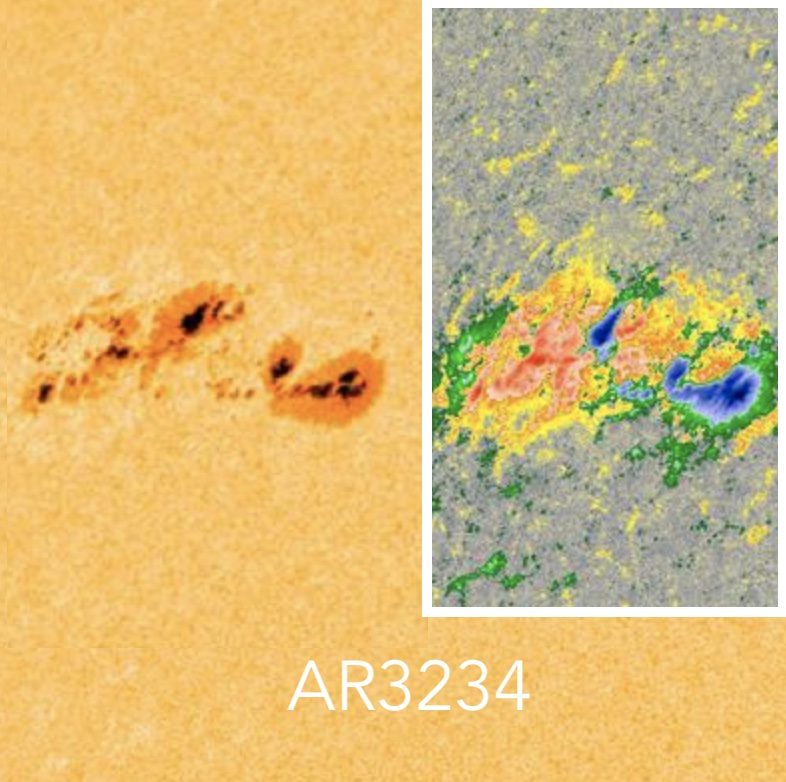
Sun activity for February 22, 2023: A big M flare, plus more
Sun activity is high due to an M5.1 flare from AR3224, along with 3 additional M flares. AR3224 and AR3229 both have a beta-gamma magnetic configuration. This is not the most magnetically complex possible configuration, but it’s complex enough for more M flares with a slight chance for an X flare. Perhaps the sun will give us some even larger flares today. Stay tuned!
Last 24 hours: Sun activity is high with an M5.1 flare at 20:30 UTC from AR3224. The region also produced 3 additional M flares along with most of the 12 C flares during that period. The list of M flares is:
M1.6 at 11:14 UTC February 21, 2023, from AR3224
M4.7 at 11:31 UTC February 21, 2023, from AR3224
M5.1 at 20:30 UTC February 21, 2023, from AR3224
M1.4 at 05:27 UTC February 22, 2023, from AR3224.
The sun has seven labeled sunspot regions.
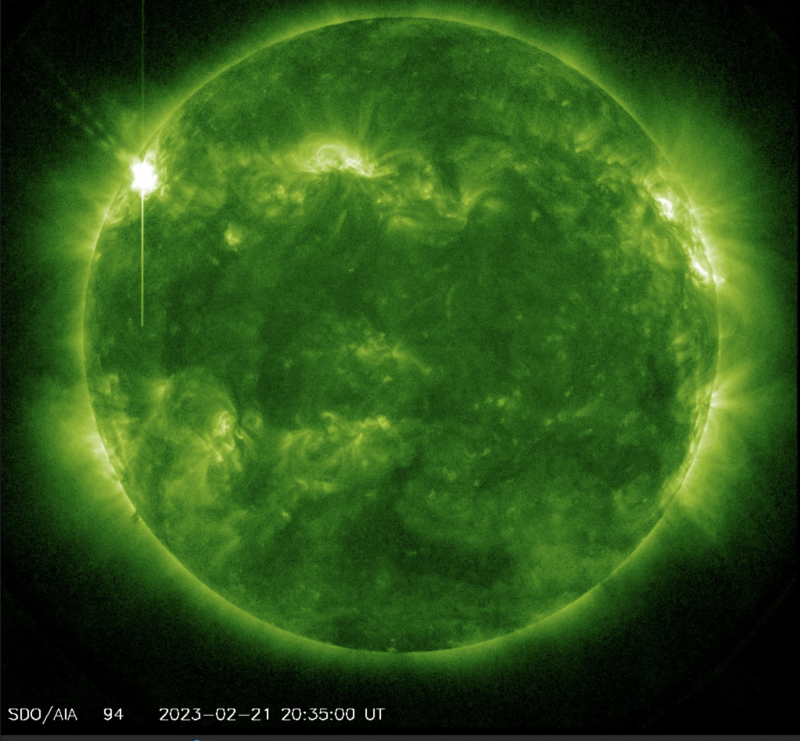
Sun activity February 21, 2023: Weak CME strike, and 2 M flares
The powerful X2.2 flare that exploded on the sun on February 17 sent a coronal mass ejection (CME) in Earth’s direction. But the CME only struck a glancing blow on Earth’s magnetic field yesterday (February 20, 2023). And the anticipated big geomagnetic storm didn’t happen as expected, although conditions did reach Kp3. Meanwhile, on our star, we saw a strong M4.4 flare at 14:58 UTC yesterday. Editor’s Note: The sun also blasted out an M1.6 flare at 11:11 UTC this morning (February 21). It caused an R1 (minor) radio blackout over the west coast of South Africa.
Last 24 hours: Sun activity is moderate, with an impulsive M class flare produced by newcomer AR3234 on February 20 (and another one at this writing). So AR3234 was the sun’s most active region yesterday, with seven flares, the 2 Ms included. Overall, in the past 24 hours, the sun produced 11 flares: the two Ms, plus nine Cs. Today’s sun has eight numbered sunspot regions.
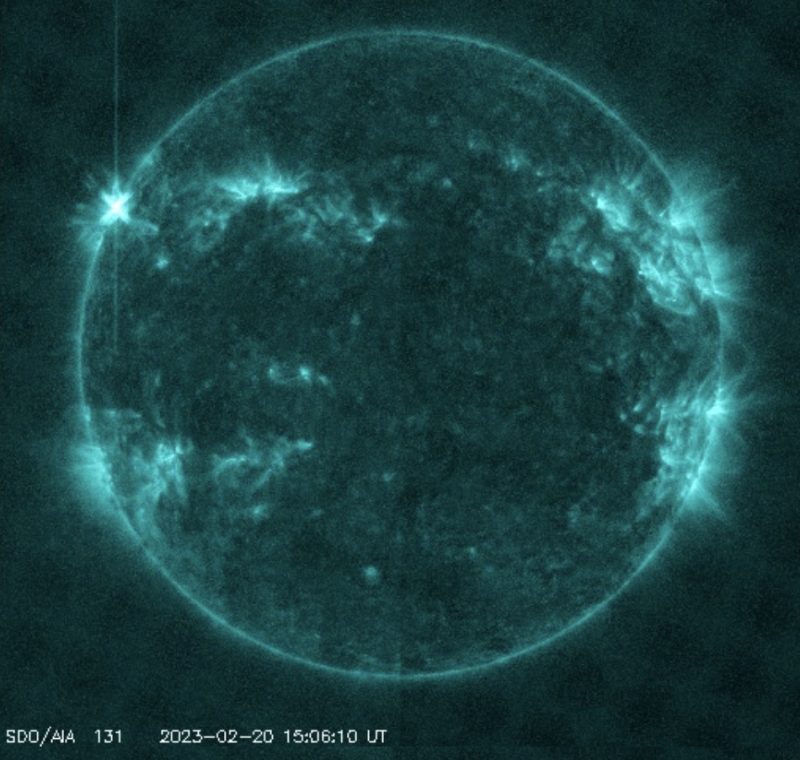
Sun activity February 20, 2023: Storm anticipated
Current solar activity is low, as we wait for the expected G1 (minor) geomagnetic storm. The impact of the Earth-directed component of the coronal mass ejection (CME) from the X2.2 flare has not happened yet as of this writing (11 UTC on February 20), but it is thought to be imminent. The possible extent of the resulting geomagnetic storm has been downgraded to a range of G1 (minor) to G2 (moderate), however. This could still mean a lot of auroral activity from North America to northern Europe. Now time and space will tell! Still waiting … waiting …
Last 24 hours: Sun activity is low, with 19 C flares. The largest event was a C7.1 flare from sunspot region AR3226 at 7:13 UTC on February 19. Today the sun has seven numbered sunspot regions.
Sun activity February 19, 2023: Big geomagnetic storm, possibly tonight!
The sun has calmed since the high level of activity from the X2.2 flare on February 17. Now we await a predicted geomagnetic storm – which might start as early as February 19 (late in the day) – from the Earth-directed CME associated with the X2.2 flare. Predictions are for impact late today through February 21 with storm levels from G1 (minor) to G3 (strong). This would mean auroras as far south as multiple northern U.S. states! Meanwhile, today’s predicted impact from the February 15 filament eruption appears to have missed us. Waiting … waiting … Clear skies to all the aurora watchers! Share your beautiful photos with us.
Last 24 hours: Sun activity is low, with only C flares. The largest events were two C7.7 flares from sunspot region AR3229 at 12:07 UTC and 18:41 UTC on February 18. There were ten C flares total with all but one from AR3229. Today the sun has six numbered sunspot regions.
Sun activity February 18, 2023: X flare with a CME!
Sun activity is high, with an X2.2 flare and an associated Earth-directed CME! Near the end of February 17, 2023, a sunspot region near the sun’s northeast limb (edge) produced an X2.2 solar flare with an EIT wave that blasted a billion-ton blob of solar plasma and magnetic field: a coronal mass ejection (CME). A component of the CME is directed toward Earth. It’s estimated to reach us on February 20 and produce a G1 to G3 geomagnetic storm. That could mean auroras visible well into the northern U.S. states. Exciting! The explosion created a shock wave leaving the sun at 5 million miles per hour (about 2400 km/s). This all indicates a lot of energy released in this event. So there’s a chance we’ll see more from this region. What does this all mean? More auroras! The past few days have already seen lots of auroral displays. In fact, today, we might experience the effects of a CME from February 15. This combined with the X flare and related CME means that the next several days could bring an auroral potpourri!
Last 24 hours: Sun activity is high, with an X2.2 flare from newcomer sunspot region AR3229 at 20:43 UTC on February 17. There were six C flares during the past 24 hours. Today the sun has six numbered sunspot regions.
Sun activity February 17, 2023: CME impact and auroras tonight
We’ve had geomagnetic storming over the past day. There’ve been aurora reports from all around. And now it appears a coronal mass ejection (CME) produced by a filament eruption early yesterday will arrive at Earth today. It’s expected to provoke a disturbance in Earth’s magnetic field, bringing auroras to observers in northern Europe and Scandinavia tonight, and perhaps to the U.S. and Canada beginning in early evening. A G1 (minor) storm level is anticipated, meaning auroral displays as far south as Maine and Michigan in the U.S. But specialists are saying storm levels could go up to G2 (moderate). So auroras might be seen even farther south.
Last 24 hours: Sun activity is back to low, with only nine C flares in the past day. Newcomer AR3229 was the major producer of the period with six C flares, including the largest flare of the period, a C9.1 at 21:16 UTC on February 16 on the sun’s northeast limb (edge). Today the sun bears seven numbered active regions.
Sun activity February 16, 2023: Myriads of auroras
We’ve had geomagnetic storming over the past day. In fact, a G1 (minor) storm is ongoing at this writing (11 UTC on February 16, 2023). Glancing blows from several coronal mass ejections (CMEs) – which left the sun several days ago – are the reason. So we’ve had auroras! Aurora reports are still coming in from higher latitudes. Share your beautiful photos with us. Plus, the excitement may continue. Experts are anticipating a direct impact from a CME produced by a filament eruption early yesterday. Analysis suggests it might reach Earth on the night of February 17, with conditions up to a G2 (moderate) geomagnetic storm. Stay tuned!
Last 24 hours: Sun activity is moderate. There were 19 flares, two small M flares and 17 C class. AR3214 was the major producer with five C flares. The largest flare, an M1.1, occurred at 00:32 UTC on February 16 from just over the sun’s northeast limb (edge). The M flares produced R1 (minor) radio blackouts, affecting the South Pacific Ocean and the French Polynesia.
Sun activity February 15, 2023: Happy Valentine’s night from the sun
Auroras everywhere! At the time of this writing (11 UTC on February 15), a G1 (minor) geomagnetic storm was ongoing. The threshold reaching the G1 (Kp5) level occurred at 8:30 UTC on February 15 (last night for the U.S.). Did you see the auroras? People in places like Alaska, Canada, Dombås and Tromsø in Norway, Kiruna in Sweden and Lapland in Finland, did see them. See the tweets below. And we’re in a NOAA aurora alert for the rest of February 15. Forecast conditions could reach levels as high as Kp6 or G2 (moderate). The display is due to glancing blows from several coronal mass ejections (CMEs) that left the sun February 10-11, 2023. Share your beautiful photos with us.
Last 24 hours: Sun activity is moderate. The sun produced 21 flares in the past 24 hours, four M flares and 17 C class. AR3213 was the major producer of past 24 hours, with the M flares, plus 15 C flares. It has now departed over the northwest limb (edge). The largest flare of the day was a M2.7 at 21:49 UTC on February 14. The sun has 10 labeled sunspot active regions today. Here are the M flares in detail:
February 14, 2023, 21:49 UTC, M2.7 flare from AR3213
February 15, 5:07 UTC, M1.1 flare from AR3213
February 15, 5:30 UTC, M2.0 flare from AR3213
February 15, 7:28 UTC, M1.4 flare from AR3213
Sun activity February 14, 2023: Possible auroras tonight
Auroras tonight? Maybe. Earth might feel the glancing blow today or tonight from several coronal mass ejections (CMEs) that left the sun February 10-11, 2023. We could see a G1 (minor) geomagnetic storm and possibly enhanced auroral displays at high latitudes: Alaska, Canada, the northern U.S. and Europe. Meanwhile, on the sun, there’s a newcomer sunspot group, AR3226. It has shown rapid growth in size and magnetic complexity. It quickly emerged out of nowhere and announced itself with two M flares. Will it be the next exciting group? We’ll be watching.
Last 24 hours: Sun activity is moderate. The sun produced 19 flares in the past 24 hours: the two M flares from AR3226 and 17 C flares. The two M flares occurred at 15:56 UTC on February 13, and 2:03 UTC on February 14. Both caused R1 (minor) radio blackouts, first in South America, then in Australia. The sun is back to having 12 labeled sunspot active regions today. AR3226 was the top flare producer of the day, with 12 flares including the two M flares.

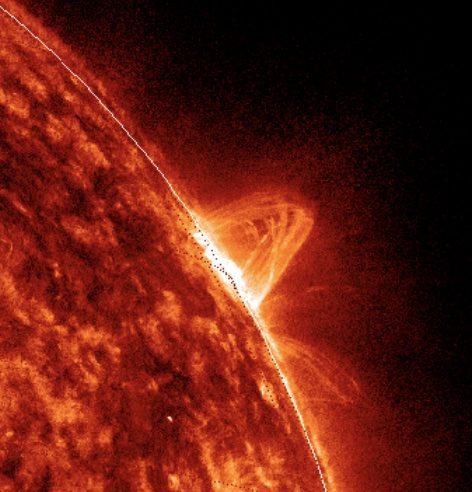
Sun activity February 13, 2023: The sun takes a breather
After a lot of excitement last week – many M flares, leading up to an X flare on February 11, 2023 – the sun has been relatively calm for the past day. Most of the visible sunspot groups have decayed in size and magnetic complexity. We had three small M flares in the past day, and the rest were C flares. Periods of intense activity – like what we just experienced – will become more frequent as we get closer to solar maximum. Each active period will also generally be more intense. And in between … the sun will take a breather. The peak of the sun’s 11-year cycle is coming (due around the middle of this decade). So stayed tuned for the next round of solar excitement!
Last 24 hours: Sun activity is moderate. The sun produced 16 flares in the past 24 hours: three M flares and 13 C flares. The sun has 11 labeled sunspot active regions today. Here are the M flares in detail:
February 12, 2023, 13:44 UTC, M1.2 flare from AR3222
February 12 16:01 UTC, M1.0 flare from AR3217
February 13 5:43 UTC, M1.1 flare from NE limb (edge)
The M flares of the period produced corresponding R1 (minor) radio blackouts, all of them affecting areas in Earth’s Southern Hemisphere. Why Southern Hemisphere? It’s because sunlight is striking the Southern Hemisphere more directly now than our part of the globe (it’s winter here, but it’s summer there).
Sun activity February 12, 2023: X-flare!
X flare! As we mentioned yesterday, of the 12 sunspot regions now on the sun’s visible surface, AR3217 was most expected to blast a large flare. And it did – an X1.1 flare – at 15:48 UTC on February 11, 2023. The event produced an R3 (strong) radio blackout over South America.
Last 24 hours: Sun activity is high. The sun produced 16 flares in the past 24 hours: one X flare, eight Ms, and seven Cs. The sun has 12 labeled sunspot active regions today. Here are the X and M flares in detail:
February 11, 2023, 11:22 UTC, M1.1 flare from AR3220
February 11 11:41 UTC, M1.4 flare from AR3222
February 11 12:15 UTC, M1.5 flare from AR3217
February 11 12:28 UTC, M1.1 flare from AR3217
February 11 12:49 UTC, M1.5 flare from AR3227
February 11 15:54 UTC, X1.1 flare from AR3217
February 11 17:31 UTC, M1.4 flare from AR3208
February 12 08:52 UTC, M3.1 flare from AR3217
February 12 09:37 UTC, M1.4 flare from AR3227
The M flares of the period produced corresponding R1 (minor) radio blackouts, all of them affecting areas in Earth’s Southern Hemisphere. Why Southern Hemisphere? It’s because sunlight is striking the Southern Hemisphere more directly now than our part of the globe (it’s winter here, but it’s summer there).
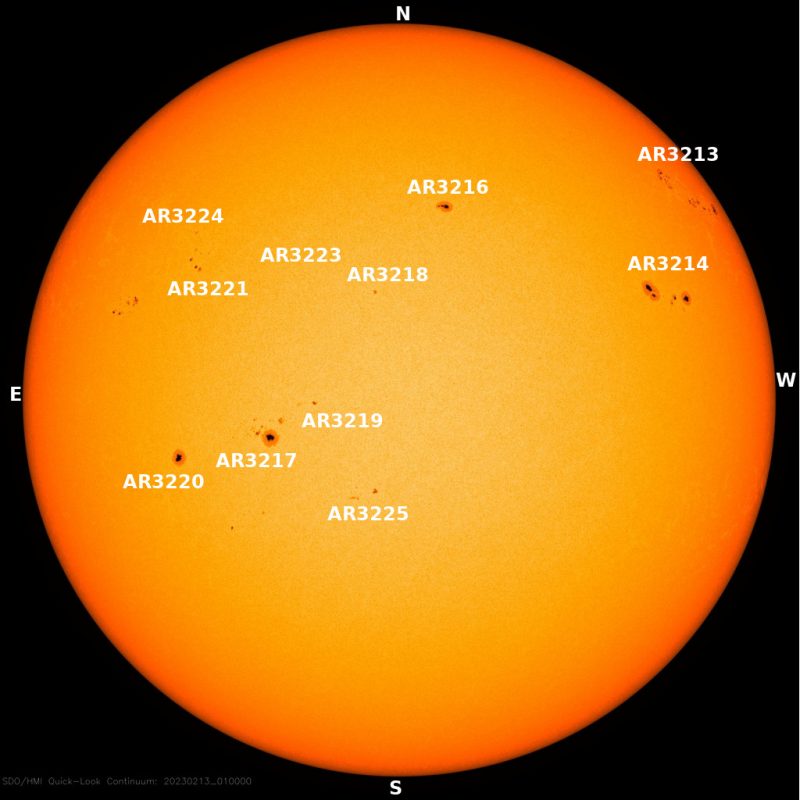
Sun activity February 11, 2023: And then there were 12
We see 12 labeled sunspot regions today, the highest number so far this year. No one is surprised. The sun has an 11-year cycle of activity, and we’re currently in an upswing of the cycle, heading for another solar maximum in mid-decade. Some of the 12 regions visible today show interesting size and magnetic complexity. For instance, AR3217 shows a beta-gamma-delta configuration, giving it a high potential for M and X flaring.
Last 24 hours: Sun activity continues at moderate levels. The sun produced 21 flares in the past 24 hours: five Ms and 16 Cs. The sun has 12 labeled sunspot active regions today. Here are the five M flares in detail:
February 10, 2023, 14:55 UTC, M1.2 flare from AR3213
February 10 16:01 UTC, M1.7 flare from AR3213
February 10 16:00 UTC, M1.6 flare from AR3213
February 10 22:41 UTC, M1.3 flare from AR3220
February 11 08:08 UTC, M2.2 flare from AR3208
The M flares of the period provoked corresponding R1 (minor) radio blackouts, all of them affecting areas in Earth’s Southern Hemisphere.
Sun activity February 10, 2023: More Ms, plus mesmerizing prominences
Sun activity is ongoing at moderate levels, with five M flares in the past day (detail below). And there’s also mesmerizing activity on the Earth-facing side of our star, in the form of an eye-catching, long-lasting tornado look-alike (a strong prominence) at the sun’s north pole. See it in our image below, bravely whirling, casting plasma into space. Also, in the past day, a long filament erupted on the sun’s southwest quadrant, while the east limb (edge) likewise was active (see animations below). Also on the southwest limb (edge), a gorgeous prominence came from AR3212. And all this happened in less than 24 hours. And know that despite its being technically considered a “moderate” level of activity, we’re seeing beautiful action on our star! Meanwhile, on Earth, a G1 (minor) geomagnetic storm (Kp5) was observed late on February 9, 2023. The threshold was reached at 23:54 UTC. It was nighttime in Europe, including Scandinavia. Unsettled to active levels reported in locations like Dombås and Tromsø in Norway. This disturbance reached northern states in the U.S. such as Maine and Michigan and more action is expected. Alert for aurora chasers! We will keep watching and provide our reports. Stay with us.
Last 24 hours: Sun activity is moderate. There were 20 flares, five M class and 15 C class flares. The largest was an M3.7 flare from AR3213.
Here are the M flares in detail:
February 9, 2023, 14:56 UTC, M1.5 flare from AR3213
February 9, 2023, 15:25 UTC, M1.4 flare from AR3217
February 9, 2023, 18:42 UTC, M1.8 flare from AR3213
February 10, 2023, 03:03 UTC, M3.7 flare from AR3213
February 10, 2023, 08:05 UTC, M1.4 flare from AR3213
Sun activity February 9, 2023: M flares keep coming
Sun activity continued at moderate levels in the past day, with a string of seven M flares. The activity is centered in the sun’s northern hemisphere and the southeast limb (edge), from sunspot region AR3213 and newcomer region AR3217, respectively. It almost appeared like a back-and-forth between the two regions with each responding to the other. AR3213 is the most magnetically complex and largest active region on the Earth-facing side of our sun. Each one of the M flares produced a corresponding R1 (minor) radio blackout. The largest and most recent one affected South Africa’s east coast and Madagascar. There is another newcomer, AR3218, just labeled on the northeast quadrant near the limb (edge).
Last 24 hours: Sun activity is moderate. There were 19 flares, seven M class and 12 C class flares. The largest was an M3.1 flare from AR3217. Here are the M flares on detail:
February 8, 2023, 16:03 UTC, M1.6 flare from AR3213
February 8, 2023, 20:12 UTC, M1.5 flare from AR3217
February 8, 2023, 21:13 UTC, M1.7 flare from AR3213
February 8, 2023, 21:37 UTC, M1.7 flare from AR3213
February 9, 2023, 03:10 UTC, M3.1 flare from AR3217
February 9, 2023, 07:17 UTC, M1.1 flare from AR3217
February 9, 2023, 09:07 UTC, M2.9 flare from an unnumbered sunspot region
The sun has eight labeled sunspot regions today.
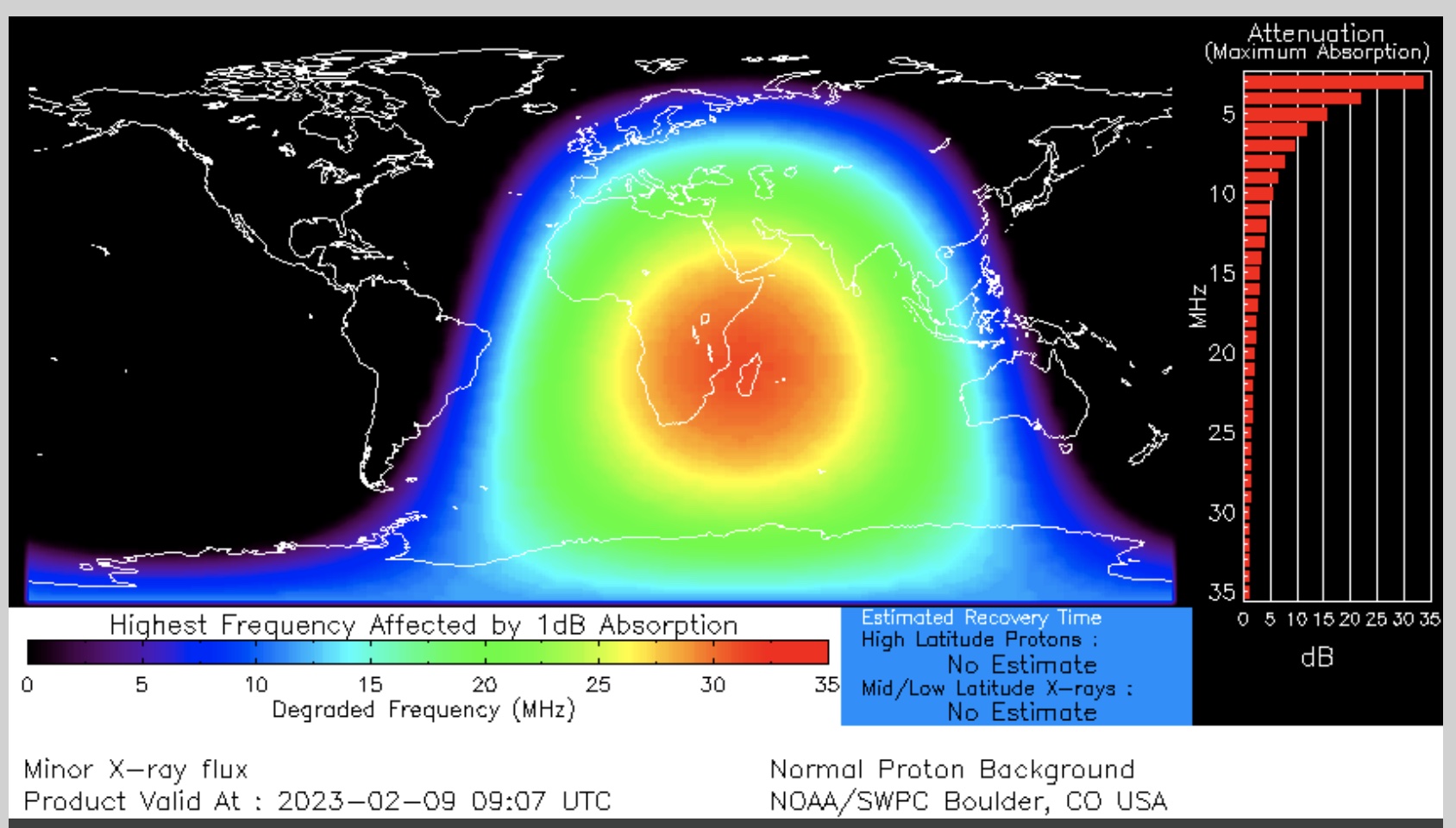
Sun activity February 8, 2023: Two consecutive M flares
Sun activity has bumped up to moderate! After a few days of quiet, there was increased flaring over the past day, five M flares in all, including two M flares back-to-back. The consecutive flares came from sunspot region AR3213, which was the day’s biggest flare producer overall, with 16 total flares, some Ms and some less-strong Cs. This region is now centrally placed on the Earth-facing side of the sun’s northern hemisphere.
Last 24 hours: Here’s a listing of the five M flares over the past day:
February 7, 2023, 13:53 UTC M1.0 flare from unlabeled active region
February 7, 2023, 20:07 UTC, M1.5 flare from AR3213
February 7, 2023, 22:58 UTC, M3.8 flare from AR3213
February 7, 2023, 23:07 UTC, M6.4 flare from AR3213
February 8, 2023, 2:53 UTC, M2.1 flare from AR3213
There were also 15 C flares. Notice we got an M flare from the as-yet-unlabeled active region in the sun’s southeast. This region hasn’t fully rotated into view yet. But it holds promise for more sun fun in the coming days! Meanwhile, all the M flares over the past day produced an R1 (minor) radio blackout on Earth except for the M6.4 which produced an R2 (moderate) blackout. The sun has seven labeled sunspot regions today.
Sun activity February 7, 2023: Auroras reported and more coming
For most of the past 24 hours, Earth’s magnetic field has been at disturbed to active levels. The Kp index reached Kp4 (active) which is just below storming. This threshold was reached a couple of times, most recently at 21:01 UTC (3 p.m. CT) on February 6. Conditions for more auroras are expected for tonight. Aurora chasers, be alert in places like Reykjavik, Tromsø, Kiruna in Sweden, Canada, and Alaska. The northernmost U.S. states might at least see some auroras on the horizon. All this is due to high-speed solar wind from a coronal hole and a glancing effect from the CME produced on February 3.
Last 24 hours: Overall flaring is low, but increasing with several new sunspots and AR3113 increasing in magnetic complexity. There are nice long lasting prominences on the sun’s eastern limb (edge) close to the equator. There were 22 C flares over the past day. The largest was a C7.8 flare (almost an M flare) at 11:58 UTC on February 6, 2023. It came from sunspot region AR3211, and this region also produced 15 of the C flares. The sun now has nine labeled sunspot regions.
Sun activity February 6, 2023: More action on the limb
Low sun activity continues. But we’re still seeing activity on the sun’s eastern limb (edge), the side that’s rotating into view. A nice eruption of material occurred in the southeast around 14 UTC on February 5, 2023 (see animation above). Just after that, slightly farther south on the sun, a small prominence lifted off the limb (edge). Meanwhile, more potential action is coming around the corner in the northeast, in the form of two newly labeled sunspot regions just beginning to rotate into view (they’re so new, they’re not on today’s sunspot image). One of them appears to be moderately sized from the initial view. Maybe things are started to pick up!
Last 24 hours: Sun activity is low with three C flares. The largest was a C6.4 flare occurring at 10:37 UTC on February 5, 2023, from AR3211. The sun has nine labeled sunspot regions today.
Sun activity February 5: Far side eruption
Low sun activity continues. But we’re seeing some increased flaring on the sun’s northeast and southeast limbs (edge). This activity might indicate new regions rotating into view. A C6.7 flare came from the southeast limb (edge), but given that it was partially blocked by the sun, was probably larger, maybe in the M range. The event produced an eruption of solar plasma that shot off eastward away from the sun, not in the direction of Earth (see the animation in SUVI 304) from about 3:16 UTC to 4:22 UTC. Using the sun’s own vibrations, we can see through the sun – in other words, using helioseismology – we can see two regions just over the sun’s limb (edge), one in the north and one in the south. It appears that the larger one is in the north. These regions should start to appear within the next 24 to 48 hours. Stay tuned for what may be just around the bend!
Last 24 hours: Sun activity is low with five C flares. The largest was a C6.7 flare occurring at 3:16 UTC on February 5, 2023. It came from over the southeast limb (edge). The sun has five labeled sunspot regions.
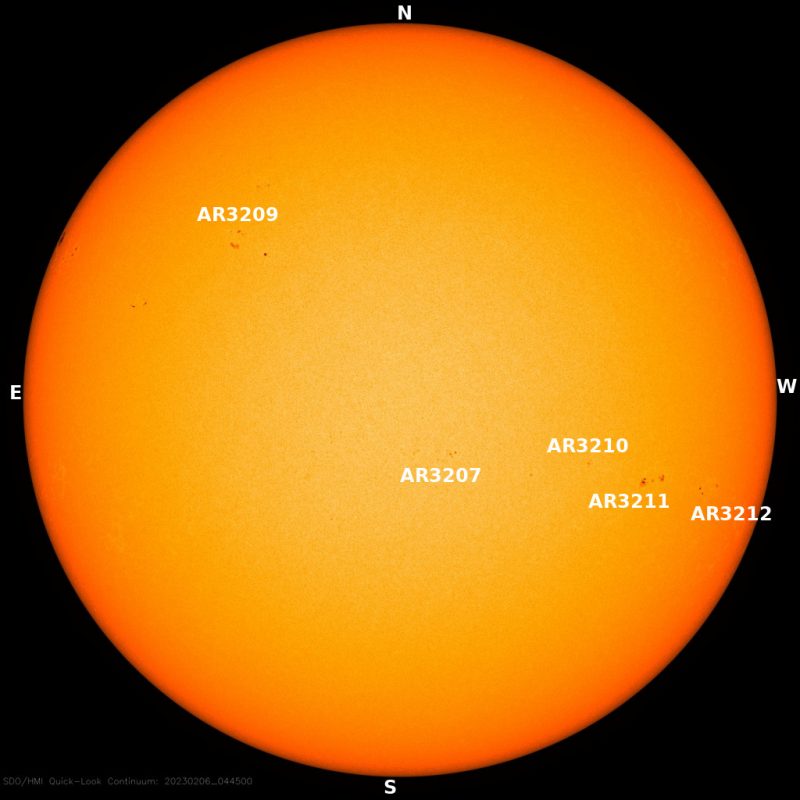
Sun activity February 4: The far side, where the action is
Sun activity on the Earth-facing side of our star continues low. But there’s action on the far side! We mentioned it in a previous post this week, and today is confirmed. Just take a look at the animation below, showing fiery prominences on the sun’s northeast limb (edge). You can see that those prominences were produced on the far side. And – since they are in the east, the side now rotating into view – those active regions will soon be in view. From another perspective, let’s take a look to our sun through AIA 193 Angstrom to see how a coronal hole is formed. The timespan in the animation below extends over one week. Notice that, slowly, dark areas pop on the sun’s northeast (upper left) quadrant to form a coronal hole. Those dark areas can be noted as coronal holes on the synoptic map NOAA specialists use in their daily analysis. Interesting!
Last 24 hours: Sun activity is low: only seven flares, all C class. The largest was a C2.9 flare occurring at 16:45 UTC on February 3, 2023, it blasted out from active region AR3207. The sun bears six labeled sunspot regions today. Chances for C, M and X flaring are going down.
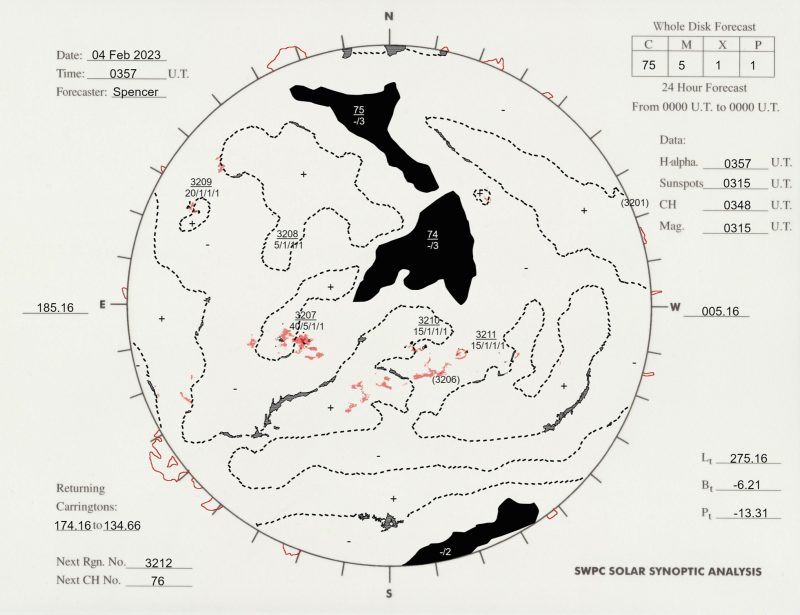
Sun activity February 3: Prominence crown look-alike on the sun
Sun activity continues at low levels. But we have seen activity on the north limb (edge) in the past days via beautiful prominences adorning our star. It seems that the action is on the far side of our star. During this past 24 hours, we saw a long-lasting prominence crowning the sun. This crown look-alike prominence started at around 10:30 UTC on February 2 and continues dancing on the sun’s north pole at the moment of this writing (11:00 UTC on February 3). On the animation below, you can see how the plasma ejected doesn’t leave the sun but swirls over its north pole. It makes the sun look like The Sun King with its crown. Meanwhile, we have been following Comet 96P/Machholz, and now it is entirely gone from LASCO C3 imagery. It successfully went through its perihelion. Take a look at our animation below showing its whole trip around the sun during its perihelion as captured by LASCO C3. Notice how bright it gets as it approaches the sun. Farewell 96P/Machholz, see you in 5.29 years in your next perihelion around the sun! In the meantime, to our readers, stay with us.
Last 24 hours: Sun activity is low. The flaring production of the day was five flares, three B class and two C class flares. The largest was a C3.9 flare occurring at 2:49 UTC on February 3. The sun bears four labeled sunspot regions today. Chances for C, M and X flaring are going down.
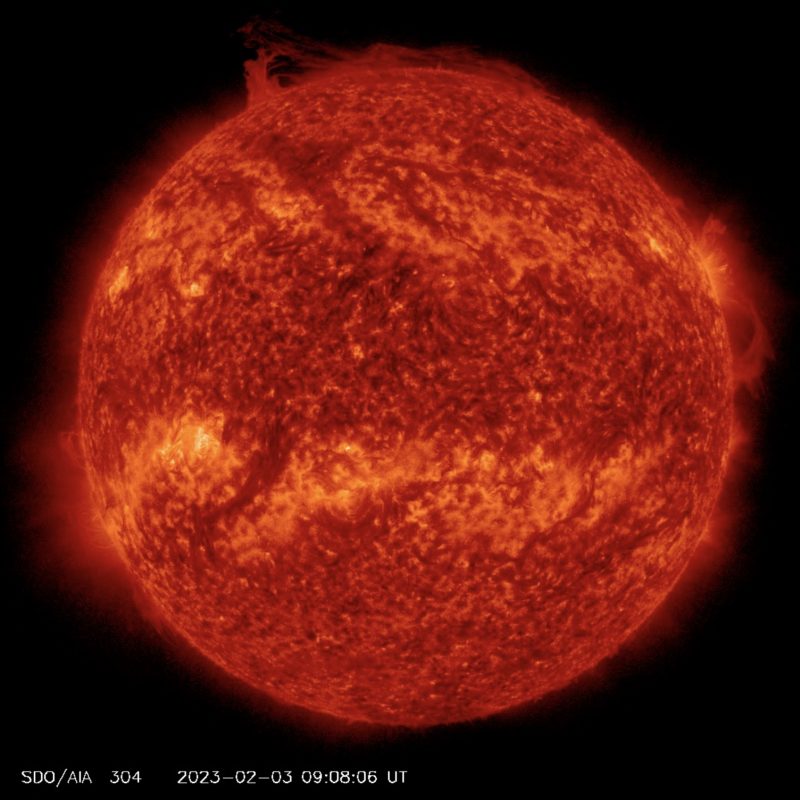
Sun activity February 2: Unexpected auroral displays
Sun activity is low with only four C class flares. Despite the sun’s low activity, an unexpected component of a weak CME arrived at Earth combined with high-speed solar wind coming from a coronal hole. All this provoked disturbances in Earth’s geomagnetic field to unsettled levels after a disturbance was recorded at 19:03 UTC. Specialists call it a transient when the source of the phenomena is uncertain. It was nighttime in Europe and Scandinavia; auroral displays were reported from Iceland and Norway. Did you see the auroras last night? Share your beautiful photos with us. Submit them here: EarthSky Community Photos. In addition to this excitement, the sun blasted out a beautiful filament-prominence on the northwest at 9:00 UTC on February 2, 2023. Stay tuned for more fun!
Last 24 hours: Sun activity is low with just four C flares from sunspot region AR3204. The largest, a C5.8 flare, occurred at 22:48 UTC on February 1. The sun has four labeled sunspot regions today.
Sun activity February 1: Massive prominence eruption
Sun activity remains low. But a massive prominence eruption on the sun’s northwest corner this morning broke the calm. See it in the animations above and below. The billions of tons of solar material flew off at millions of miles per hour … but not in Earth’s direction. Meanwhile, our favorite sun visitor, Comet 96P Machholz – named for the late, great comet-hunter and our friend Don Machholz – has rounded the sun and is now heading outward again. See the most recent image captured by SOHO’s LASCO C3 camera, below. The comet is expected to leave LASCO’s field of view by February 3. Read more about Comet 96P Machholz.
Last 24 hours: The sun produced 13 C flares, and a few B flares. Sunspot region AR3207 produced the largest blast, a C4.8, at 11 UTC on February 1. All but 2 of the C flares came from this region. The sun has five labeled sunspot regions today.
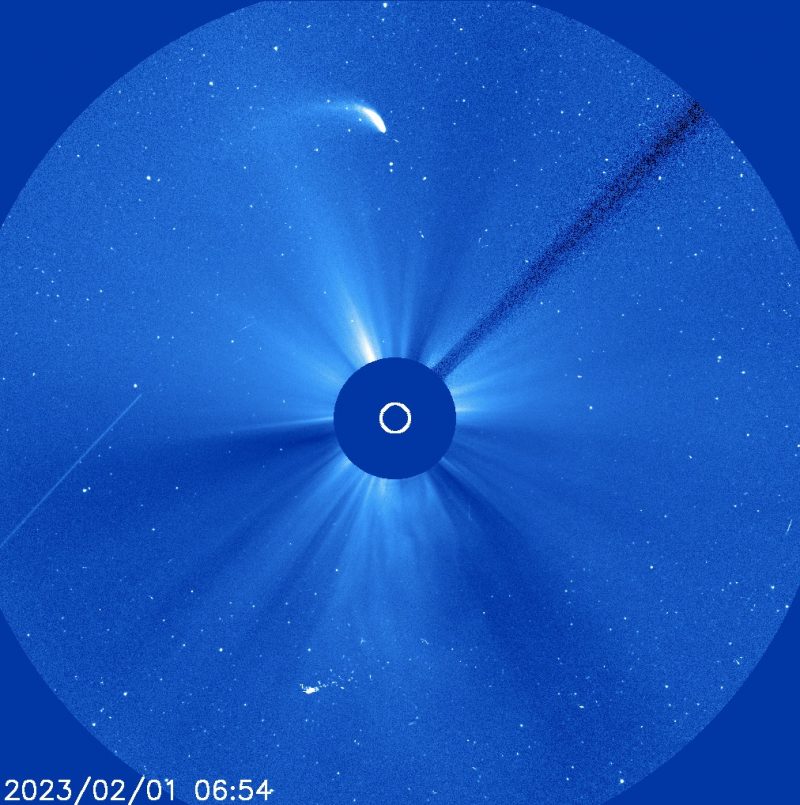
Bottom line: Sun activity archive for February 2023. A daily record of flaring, big filaments and prominences, and other sorts of activity, on our local star.











